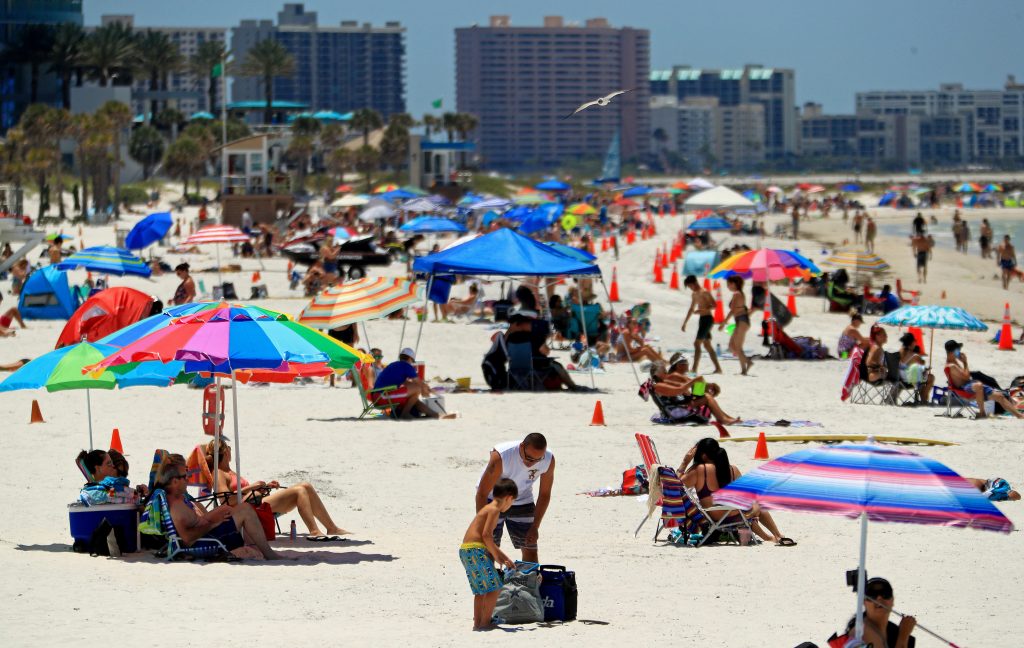
Stocks rallied on Friday, clawing back some of the sharp losses from Wall Street’s worst day since March.
The Dow Jones Industrial Average traded 831 points higher, or 3.3%. The S&P 500 gained 2.9% while the Nasdaq Composite advanced 2.8%.
Despite those sharp gains, the major averages were all on pace to post their first weekly losses in four weeks. The Dow and S&P 500 are both down more than 3% week to date while the Nasdaq has lost 0.6%.
Investors on Friday went right back into the plays whose fates hinge on a successful reopening of the economy. Carnival Corp jumped 11.1%. United Airlines climbed 11.2%. Other winners included brick-and-mortar retailers Kohl’s and Gap. Those stocks were hit big time during Thursday’s sell-off as investors feared the reopening of the economy could be delayed by a second wave of cases.
Even after Friday’s bounce, Morgan Stanley Investment Management’s Andrew Slimmon said: “Given the magnitude of the rally, it would shock me if we had a one day sell-off and that’s it.”
“The stocks that are up the most from the lows are still the risk-on, high beta, value, small-cap stocks,” Slimmon, who is a managing director and senior portfolio manager at the firm, told CNBC’s “Squawk Box Asia” Friday morning Singapore time. “They’re still the big winners and I would suspect that there’s more pain to come near-term before the market clears out kind of this excessive speculation that we’ve seen recently.”
Wall Street’s fear gauge signaled more wild trading ahead. The Cboe Volatility Index on Thursday jumped to trade above 40 for the first time since May 4. The VIX remained elevated Friday morning, above 36.
The S&P 500’s gains on Friday put the index back above its 200-day moving average, a widely followed level by traders. The broad market index posted closed below that level on Thursday for the first time since May.
“Once the S&P 500 crossed above the 200-day moving average [last month], it gave investors the green light to buy stocks; it said things are OK with the economy,” said Mitchell Goldberg, CEO of ClientFirst Strategy. “It also signaled hedge fund managers who got too heavy into cash are now way behind their benchmarks and are now performance-chasing.”
The Dow, S&P 500 and Nasdaq on Thursday all recorded their biggest one-day losses since mid-March, posting losses of at least 5%.Thursday’s declines put the Dow and S&P 500 on pace for their biggest weekly losses since March 20, when they all dropped at least 12% amid broad economic shutdowns stemming from the pandemic.
Thursday’s losses came after data compiled by Johns Hopkins University showed the number of new coronavirus cases has risen in states like Arizona, South Carolina and Texas as they continue their reopening process. Arizona cases have nearly doubled since Memorial Day.
Still, Treasury Secretary Steven Mnuchin told CNBC’s Jim Cramer the U.S. can’t shut down the economy again.
Overall, more than 2 million coronavirus cases have been confirmed in the U.S. along with over 100,000 deaths.
Stocks had been ripping higher prior to this week, as investors cheered the prospects of the economy recovering as states and countries eases quarantine measures.
“We had gone straight up more than 30% without a real sell-off, so you’re due for one, and I don’t think it’s the worst thing in the world,” said JJ Kinahan, chief market strategist at TD Ameritrade. “As more states get back, the question becomes: Are they going to ramp up fast enough to please Wall Street? What you’re seeing is it’ll be hard to do that.”
Despite Thursday’s sell-off, the S&P 500 and Dow remained more than 37% above the intraday lows reached on March 23. Most of those gains have been driven by stocks that would benefit from the economy reopening, including airlines, cruise lines and retailers.
“Some of these stocks may have gotten ahead of their skis,” said Kinahan. “When you see some of the airlines being priced at the levels they were before this all started when they say they’re going to do 60% of their business just doesn’t make sense.”
Consumer sentiment data along with the latest U.S. import and export numbers are scheduled for release Friday morning.
Subscribe to CNBC PRO for exclusive insights and analysis, and live business day programming from around the world.

